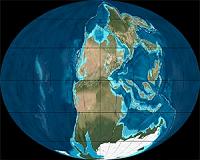| . |  |
. |
Edmonton, Canada (SPX) Nov 04, 2010 A University of Alberta geomicrobiologist and his PhD student are part of a research team that has identified phosphorus as the mystery ingredient that pushed oxygen levels in the oceans high enough to establish the first animals on Earth 750 million years ago. By examining ancient-ocean sediments, Kurt Konhauser, student Stefan Lalonde and other colleagues discovered that as the last glacier to encircle Earth receded, leaving behind glacial debris containing phosphorus that washed into the oceans. Phosphorus is an essential nutrient that promoted the growth of cyanobacteria, or blue-green-algae, and its metabolic byproduct is oxygen. The new, higher oxygen levels in the ocean reached a threshold favourable for animals to evolve. Konhauser's past research into ancient phosphorus levels in a unique suite of rocks called banded iron formations led him and his colleagues at the University of California Riverside to their current findings. In 2007, Konhauser and his U of A team published research in the magazine Science that was contrary to the then-accepted theory that phosphorus was scarce throughout much of Earth's history, it was in fact plentiful. "Now in 2010 we showed that phosphorus levels actually peaked between 750 and 635 million years ago at the very same time that oxygen levels increased, allowing complex life forms to emerge," says Lalonde. "That establishes our link between phosphorus and the evolution of animals." Konhauser and Lalonde were co-authors on the paper published Oct. 27 in Nature.
Share This Article With Planet Earth
Related Links University of Alberta Explore The Early Earth at TerraDaily.com
 Cincinnati's Algeo Tracks Evidence Of The Great Dying
Cincinnati's Algeo Tracks Evidence Of The Great DyingCincinnati OH (SPX) Nov 03, 2010 More than 251 million years ago, at the end of the Permian period, Earth almost became a lifeless planet. Around 90 percent of all living species disappeared then, in what scientists have called "The Great Dying." Thomas J. Algeo, has spent much of the past decade investigating the chemical evidence buried in rocks formed during this major extinction. The University of Cincinnati professor ... read more |
|
| The content herein, unless otherwise known to be public domain, are Copyright 1995-2010 - SpaceDaily. AFP and UPI Wire Stories are copyright Agence France-Presse and United Press International. ESA Portal Reports are copyright European Space Agency. All NASA sourced material is public domain. Additional copyrights may apply in whole or part to other bona fide parties. Advertising does not imply endorsement,agreement or approval of any opinions, statements or information provided by SpaceDaily on any Web page published or hosted by SpaceDaily. Privacy Statement |